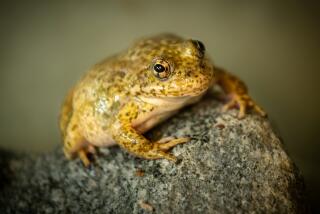‘Whoa! What’s happening?’ Horny toads are disappearing. Can they be saved?
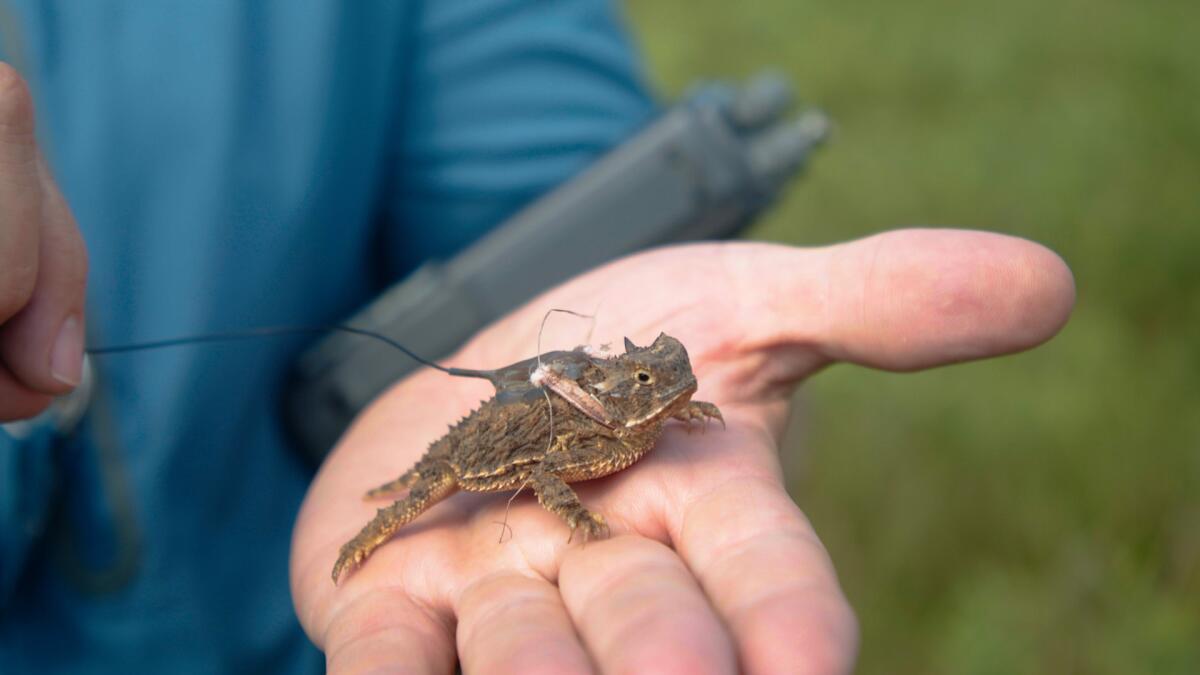
- Share via
OKLAHOMA CITY — The legend goes something like this: In 1897, the good people of Eastland, Texas, put a time capsule in the cornerstone of the courthouse being built downtown. In went a Bible, some newspapers, a bottle of whiskey.
And a Texas horned lizard.
The town grew and grew, and by 1928, it needed a bigger courthouse. The old one was torn down, and a couple of thousand people watched as the marble cornerstone was pried open. To everyone’s astonishment, the dusty critter buried 31 years earlier was still alive.
They called him Ol’ Rip, after Rip Van Winkle. To this day, his taxidermied body lies in state in a wood-and-velvet casket at the courthouse in Eastland, where there’s an annual Rips Ribs Cookoff and RipFest parade.
“He’s a pretty big deal,” said Eastland County Judge Rex Fields.
It’s hard to overstate the affection people in these parts of Oklahoma and Texas have for the Texas horned lizard, a prehistoric-looking creature with horns on its head and the ability to shoot blood from its eyes. Also called horny toads and horned frogs because of their squat, flat bodies, they are, in fact, lizards.
“They were everywhere when I was a kid,” said Fields, 63. “We’d pick them up and play with them.” Fields, as the keeper of the Legend of Ol’ Rip, tells schoolchildren the tale of the indestructible reptile. But these days many of those youngsters have never seen one before.
Which raises a question scientists are now trying to answer: What happened to the horny toads?

The Texas horned lizard — one of at least 17 known species of horned lizard — have virtually disappeared east of Interstate 35, which runs down the middle of Oklahoma and Texas, said Dean Williams, a Texas Christian University biology professor who runs the TCU Horny Toad Project.
Classified as a threatened species in Texas and a species of greatest conservation need in Oklahoma, they have been dying off for at least 60 years. But pointing to the start and extent of their decline isn’t easy.
“The problem, of course, is they used to be so common, probably one of the most common lizards in Texas,” Williams said. “People for the most part just ignored them.... Nobody started monitoring them. When they just started disappearing, people were like, ‘Whoa! What’s happening?’”
Scientists point to two major invaders: humans and fire ants.
In Texas and Oklahoma, the combined human population grew fivefold over the last century, to 33 million today from 6.7 million in 1920.
As cities expanded and highways stretched across the prairies, the lizards — which are not very mobile and prefer open habitats with sparse vegetation and loose soil — became isolated in smaller and smaller pockets.
Native grass was replaced on a massive scale with row crops and pastures of non-native groundcover like Bermuda grass, which is great for hay production and cattle grazing but too dense for horned lizards to hunt for food.
And then came the red fire ants. The invasive South American insects were accidentally imported via cargo ship into Alabama in the 1930s and steadily marched across the South, reaching Texas by the 1950s. They drove out the native, less aggressive harvester ants, which make up the bulk of horned lizards’ diet.
The fire ants also attack horned lizards’ buried nests and eat their young, Williams said.
The lizards face yet another, more natural, problem: Just about anything that can eat a horny toad will eat a horny toad. Snakes. Coyotes. Hawks. Bobcats. Roadrunners. Raccoons. Rodents.
“These things are like popcorn in the environment,” Williams said.
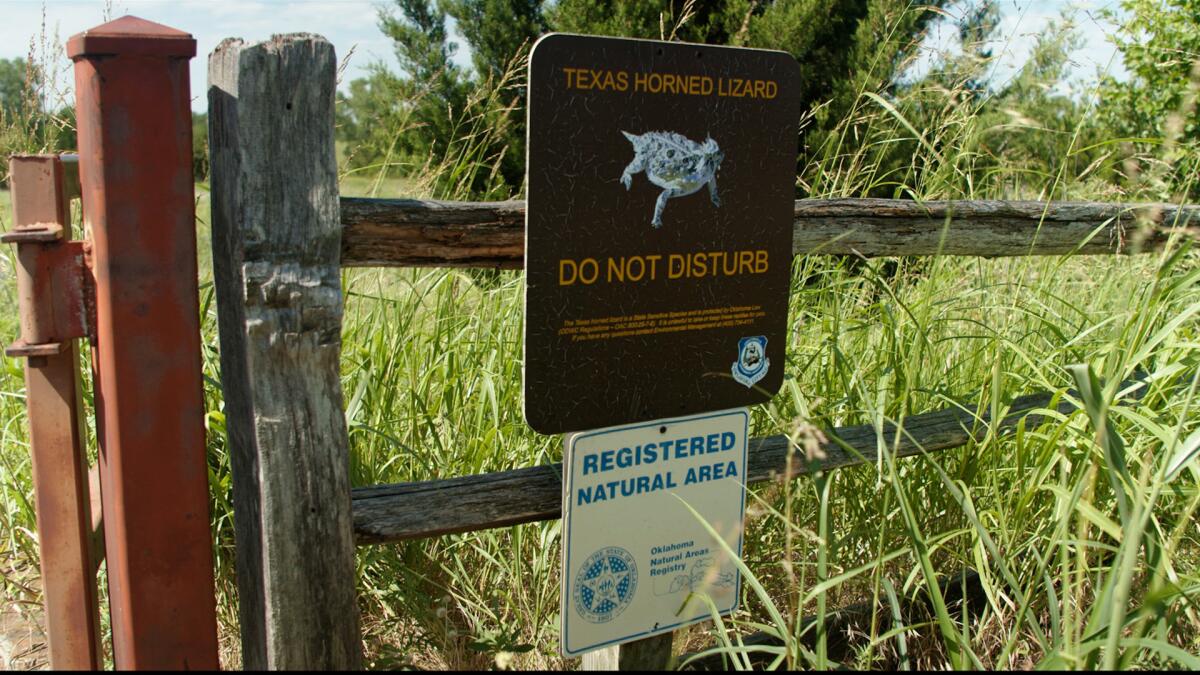
Horned lizards are not fast, and try to avoid being eaten by blending in — and looking fierce. As a last-minute defense, they shoot blood from their eyes that is distasteful to canines, like foxes and coyotes, said Nathan Rains, a wildlife diversity biologist with the Texas Parks & Wildlife Department.
Rains recalled seeing horned lizards all over his grandfather’s peach orchard near teensy Elmore City, Okla., when he was a child in the 1980s.
“Even people who don’t like lizards love horny toads,” Rains said. “They just have a face that’s so ugly it’s cute.”
It’s the official state reptile of the Lone Star State, which has license plates featuring them. The mascot at Texas Christian University is the Horned Frog. And in the little Oklahoma Panhandle town of Hooker — where the motto is “It’s a location, not a vocation” — the baseball team is called the Hooker Horny Toads.
“They’re not aggressive,” Rains added. “They’re easy to catch. They’re like a dinosaur. People saw them as a kid, and then they grow up and move to the city and start reminiscing.”
People often call the state wildlife department, he said, claiming they have the perfect property for horned lizards to be reintroduced.
Leslie Nossaman, recent president of the Austin-based Horned Lizard Conservation Society, gets those kinds of wistful calls all the time too.
“If you’ve ever held one in your hand, it’s an instant connection that almost goes to your soul,” said Nossaman, a retired geologist and geophysicist. “People describe it as a spiritual connection when they hold a horned lizard or even see one in the wild.”
The Horned Lizard Conservation Society, a nonprofit that sponsors scientific research on the critters, started in 1991. Speaking at one of its first meetings was Wade Sherbrooke, the former director of the Southwest Research Station of the American Museum of Natural History in Arizona. He was moved by people’s passion about the creatures he’d studied for more than 40 years.
“Some old rancher would get up and say, ‘We had horny toads and we should have them again! Ice cream cones and horny toads, that’s what life’s all about!’” he recalled.
But the lizard’s decline, he said, is just one tragic example of the damage humans have inflicted on this ever-warming planet.
“We have to change human behavior,” Sherbrooke said.
But change is hard. “It’s a losing battle,” he said with a sigh.
In recent years, scientists and zoos have tried a new approach to bringing the reptiles back from the brink: breeding them in captivity and reintroducing them to the wild.
The Fort Worth Zoo — which became the first zoo to successfully breed Texas horned lizards in 2001 and has since hatched more than 800 — started reintroducing them in 2011, said Diane Barber, the zoo’s curator of ectotherms. It has released more than 500 hatchlings, but it is difficult to tell how many survived because they are small and well-camouflaged.
“Although we are putting hundreds of lizards on the landscape, their chances of survivorship in optimal conditions are low due to natural predation and harsh Texas environments,” Barber said in an email. “A low 1-3% survivorship of a single egg clutch to adulthood is considered normal for many species of reptiles and amphibians in the wild. So, when we have released 100 hatchlings in one year and find 5-7 the following spring, that’s pretty darn exciting!”
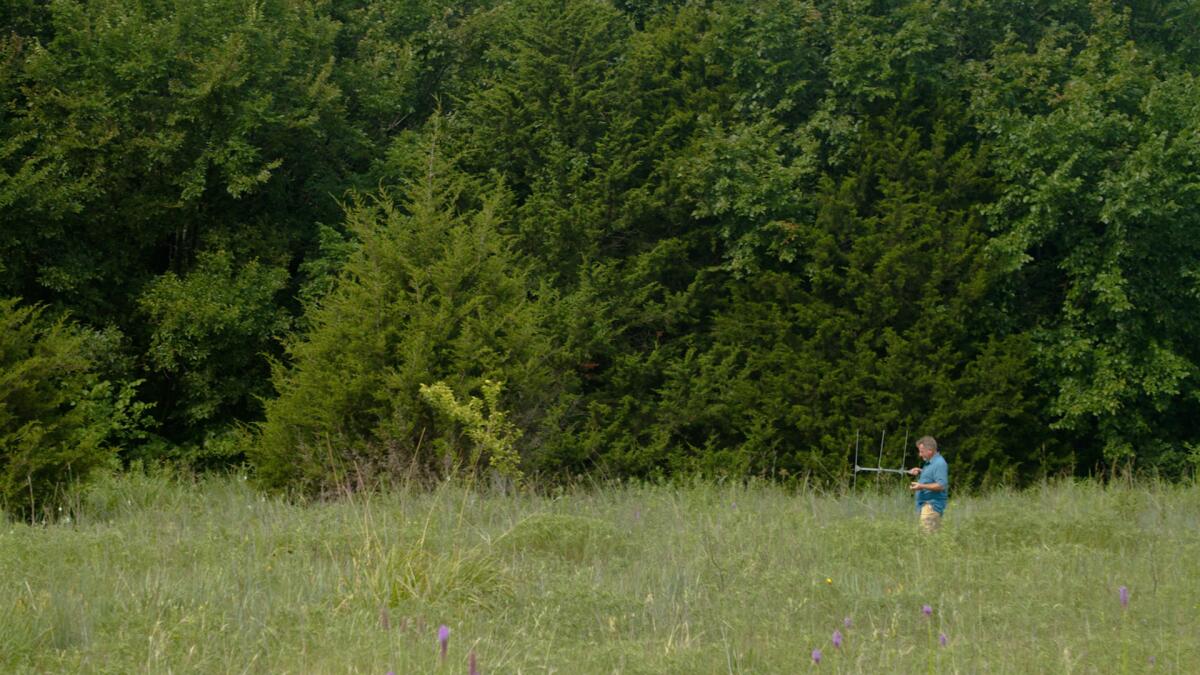
One of the country’s longest-studied populations of Texas horned lizards lives on Tinker Air Force Base in Oklahoma City, where researchers have used radio telemetry to track more than 1,000 lizards since 2003, studying their movement, health, reproductivity and survival rate.
On a triple-digit Tuesday in the summer, Raymond Moody marched through knee-high grass and Maximilian sunflowers, gently waving a long metal antenna — and watching for lightning in the wake of a morning thunderstorm.
Moody, a natural resources scientist at the base, and a small group of volunteers from the Oklahoma City Zoo searched for 2-inch lizards on a 40-acre prairie reserve on the base where 56 or so horned lizards live. Adult lizards being tracked there wear transmitters that look like little backpacks, each programmed to a unique frequency.
Moody moved quickly as his receiver beeped louder and louder, picking up the signal of lizard #1015. He followed it into a field of purple flowers, then to the edge of the woods, but couldn’t find it. It was moving fast — too fast for a horned lizard. Moody theorized it might have been eaten by a snake that was slithering away.
A volunteer’s receiver went off: Beep! Beep! Lizard #1017 was nearby.
Or so they thought. They found a tag attached to a chunk of skin. The lizard had shed its skin and left the tracker behind.
“Its fate would be unknown,” Moody noted.
Often, he finds transmitters with signs of a sad end — teeth marks.
After about two hours, Moody found #905 in the tall grass. He picked up the male, which had been tracked for about two years, and it sat still in his palm. Moody marked its location, then put him back.
“We keep the transmitters on them as long as we can, until they get eaten by a predator,” he said. “It’s really important for us to know the fate of the animal, what happens to it in the end. ... They’ve got a lot of things going against them.”
Thirty-four young horned lizards whose eggs were collected at the base in 2019 and 2020 are being raised at the Oklahoma City Zoo as part of a National Science Foundation-funded study in which researchers monitor their growth, collect stool samples and study their gut bacteria to understand how human care affects them and their ability to survive in the wild.
The horned lizards live in glass-sided terrariums with an automatic misting system to simulate rain, and are fed at random times so they don’t get on a schedule. Once past their most vulnerable life stages, they’ll be reintroduced at Tinker and tracked.
“Our hope with this kind of program is that we’re able to introduce larger, healthier animals that would have higher survivorship rates than they normally would in the wild,” said Sam Eliades, an ecology and evolutionary biology doctoral student at the University of Oklahoma who runs the zoo’s Lizard Lab.
In coming months, as part of a soft release at Tinker, the lizards will live in a semi-enclosed pen to help ease the shock of living outdoors before they are fully released this summer.
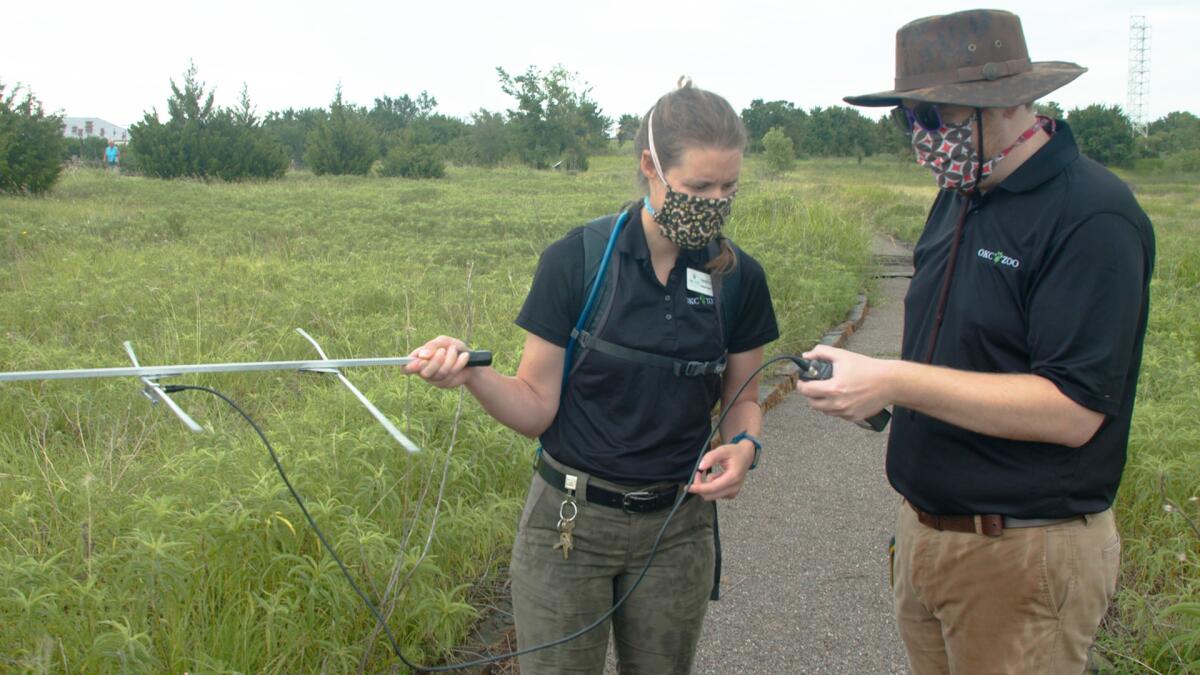
Texas horned lizards live around five years in the wild. If the story of Ol’ Rip is true, he was at least 31 when found. No wonder he made headlines around the world, including the front page of The Times.
He went on a national tour and visited President Coolidge in the White House before dying of pneumonia the next year.
Fields, the judge who maintains Ol’ Rip’s memory in Eastland, said that when John Connally was running for Texas governor in 1962, he posed for a photo with Ol’ Rip. But when Connally lifted the preserved animal up, “his dried-up leg came off and broke,” Fields said.
When children visit the courthouse, Fields makes them promise to believe the story of the indomitable lizard. They repeat a left-handed oath:
I do solemnly swear (or affirm) that I will faithfully execute the office of Ol’ Rip Promoter and will to the best of my ability promote, protect and defend to death the truth of the story of Ol’ Rip.
Texans, Fields noted, believe Ol’ Rip inspired the classic Warner Bros. cartoon “One Froggy Evening,” in which a construction worker opens a cornerstone marked 1892 and finds a live, top-hat-wearing frog who dances and sings the Tin Pan Alley tune “Hello! Ma Baby.”
Jerry Beck, an animation historian, laughed when told about Ol’Rip. He had not heard of him. But the history of many classic cartoons is not well-documented, he said, and there just might be some tie to the Texas horny toad.
“It’s not impossible,” he said.
The cartoon suggests there might be hope for the Texas horned lizard after all. The frog ends up inside another cornerstone dated 1955. Far into the future — in 2056 — another construction worker opens the cornerstone and out pops the frog, singing and dancing once more.
More to Read
Sign up for Essential California
The most important California stories and recommendations in your inbox every morning.
You may occasionally receive promotional content from the Los Angeles Times.

